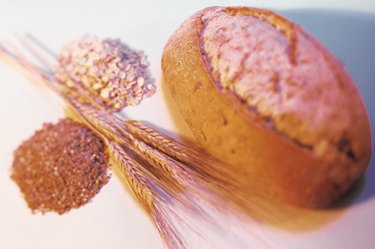
Ammonium chloride is a combination of two necessary elements for plant growth -- nitrogen and chlorine. Both are naturally occurring in the atmosphere and soil, and providing the plants with an extra source helps them reach peak growth and health. When they are deficient, the plant wilts easily, and the leaves turn yellow and brown. Growth is also stunted. Ammonium chloride is one of many forms of nitrogen that are used on crops, lawns and gardens.
Chloride and Nitrogen
Video of the Day
Chloride, a salt form of the element, should not be confused with chlorine, the gas form of the element which is manufactured from chloride. It is often found in heavy concentrations in soil near an ocean. When nitrogen is in the soil, the micro fauna convert it to a form of ammonia that plants can easily absorb. Both elements combine easily, making the compound practical to use as a fertilizer.
Video of the Day
Medium-Strength Fertilizer
Ammonium chloride is a medium-strength nitrogen fertilizer compared to other ammonium-based products. The nitrogen percentage is 25 percent, compared to ammonium nitrate at 33 percent and ammonium phosphate at 21 percent.
Crop Increase
Ammonium chloride increased crop yields by up to 40 percent over crops with no chloride added, according to a multi-year study reported on by W. E. Thompson of the Oklahoma State University Department of Plant and Soil Sciences. The chloride also significantly increased the time it took for nitrogen to disappear from unlimed soil.
Disease Prevention
Ammonium chloride is also being studied for disease prevention. Tomatoes, beans and peppers were purposefully inoculated with harmful bacteria in an alkyl dimethyl benzyl ammonium chloride solution by Dr. Kayimbi Tubajika in 2009. Up to 50 percent of the bacteria were destroyed by the solution. This compares favorably to many of the other means of protecting consumers from bacteria.
- Oklahoma State University; Journal of Plant Nutrition; Effect of Chloride Fertilizers and Lime on Wheat Grain Yield and Take-All Disease; W.E. Thompson, et al.; 2001
- University of Wisconsin; Soil and Applied Cholrine; Understanding Plant Nutrients; E.E. Schulte; 1999
- Texas Agricultural Extension Service: Fertilizing Foliage & Flowering Plants
- Taylor & Francis Group; Effectiveness of Alkyl Dimethyl Benzyl Ammonium Chloride; Kayimbi Tubajika; 2009